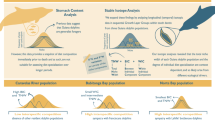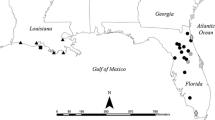I analyzed 478 diet samples of Rana nigromaculata across its natural size range to examine the dietary changes of this species during postmetamorphic ontogeny. As the frogs increased in size, they increased total diet volume, but decreased the number of prey items. Also, individuals ontogenetically increased the mean, minimum and maximum prey volume in the stomach. The mean volume of the major prey taxa consumed by the frogs varied considerably. Small prey, such as ants and dipterans, were found less frequently as the size of the frogs increased, but large prey, such as beetles and orthopterans, were more frequently recovered from larger frogs. These results suggest that ontogenetic diet change should be considered when the structure of an anuran community is investigated using food niche analysis.
Similar content being viewed by others
REFERENCES
Berry P. Y. (1966) The food and feeding habits of the torrent frog, Amolops larutensis. Journal of Zoology, London 149: 204–214.
Christian K. A. (1982) Changes in the food niche during postmetamorphic ontogeny of the frog Pseudacris triseriata. Copeia 1982: 73–80.
Donnelly M. A. (1991) Feeding patterns of the strawberry poison frog, Dendrobates pumilio. Copeia 1991: 723–730.
Duellman W. E. & Trueb L. (1986) Biology of Amphibians. McGraw-Hill Book Co, New York.
Flowers M. A. & Graves B. M. (1995) Prey selectivity and size-specific diet changes in Bufo cognatus and B. woodhousii during early postmetamorphic ontogeny. Journal of Herpetology 29: 608–612.
Hirai T. & Matsui M. (1999) Feeding habits of the pond frog, Rana nigromaculata, inhabiting rice fields in Kyoto, Japan. Copeia 1999: 940–947.
Hirai T. & Matsui M. (2000a) Myrmecophagy in a ranid frog Rana rugosa: Specialization or weak avoidance to ant eating? Zoological Science 17: 459–466.
Hirai T. & Matsui M. (2000b) Ant specialization in diet of narrow-mouthed toad, Microhyla ornata, from Amamioshima island of the Ryukyu archipelago. Current Herpetology 19: 27–34.
Hirai T. & Matsui M. (2000c) Feeding habits of the Japanese tree frog, Hyla japonica, in the reproductive season. Zoological Science 17: 977–982.
Hirai T. & Matsui M. (2001) Attempts to estimate the original size of partly digested prey recovered from stomachs of Japanese anurans. Herpetological Review 32: 14–16.
Houston W. W. K. (1973) The food of the common frog, Rana temporaria, on high moorland in northern England. Journal of Zoology, London 171: 153–165.
Krebs J. R. & Davies N. B. (eds) (1997) Behavioral Ecology. An Evolutionary Approach, 4th edn. Blackwell Scientific, London.
Labanick G. M. (1976) Prey availability, consumption and selection in the cricket frog, Acris crepitans (Amphibia, Anura, Hylidae). Journal of Herpetology 10: 293–298.
Lieberman S. S. (1986) Ecology of the leaf litter herpetofauna of a Neotropical rain forest: La Selva, Costa Rica. Acta Zoologica Mexicana 15: 1–72.
Lima A. P. (1998) The effects of size on the diets of six sympatric species of postmetamorphic litter anurans in central Amazonia. Journal of Herpetology 32: 392–399.
Lima A. P. & Magnusson W. E. (2000) Partitioning seasonal time: interactions among size, foraging activity and diet in leaf-litter frogs. Oecologia 116: 259–266.
Lima A. P. & Moreira G. (1993) Effects of prey size and foraging mode on the ontogenetic change in feeding niche of Colostethus stepheni (Dendrobatidae). Oecologia 95: 93–102.
McLaughlin R. L. (1989) Search modes of birds and lizards: evidence for alternative movement patterns. American Naturalist 133: 654–670.
Maeda N. & Matsui M. (1999) Frogs and Toads of Japan, rev. edn. Bun-ichi Sogo Shuppan, Tokyo (in Japanese with English abstract).
Newman R. A. (1999) Body size and diet of recently metamorphosed spadefoot toads (Scaphiopus couchii). Herpetologica 55: 507–515.
Toft C. A. (1980) Feeding ecology of thirteen syntopic species of anurans in a seasonal tropical environment. Oecologia 45: 131–141.
Toft C. A. (1981) Feeding ecology of Panamanian litter anurans: Patterns in diet and foraging mode. Journal of Herpetology 15: 139–144.
Toft C. A. (1985) Resource partitioning in amphibians and reptiles. Copeia 1985: 1–21.
Author information
Authors and Affiliations
Corresponding author
About this article
Cite this article
Hirai, T. Ontogenetic change in the diet of the pond frog, Rana nigromaculata. Ecol Res 17, 639–644 (2002). https://doi.org/10.1046/j.1440-1703.2002.00521.x
Received:
Accepted:
Issue Date:
DOI: https://doi.org/10.1046/j.1440-1703.2002.00521.x




